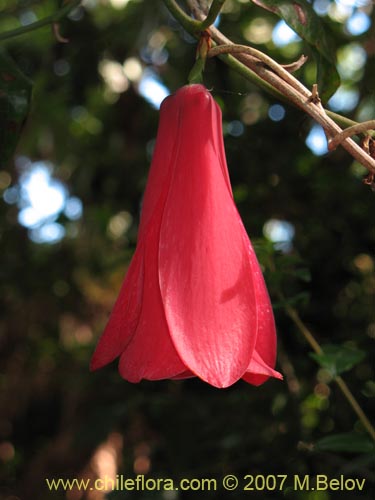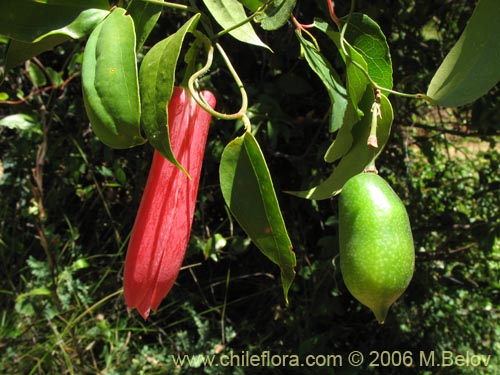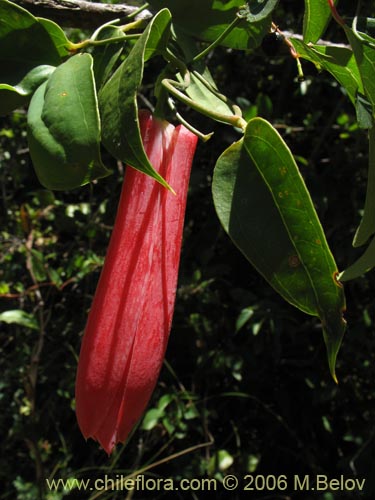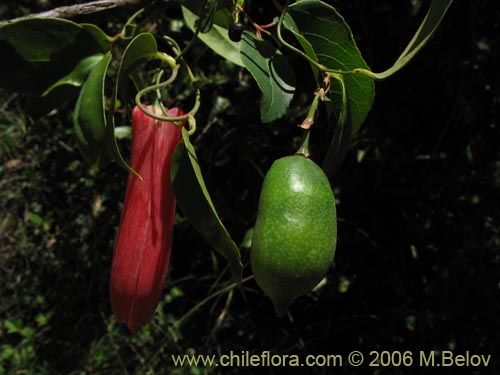|
|
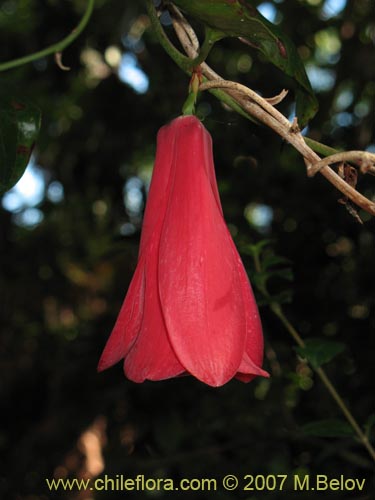
Image of Lapageria rosea
X Region, Hueicolla, Chile
Altitude: 0-200 m. 03 26, 2008
|
|
| Species: | Lapageria rosea Ruiz & Pav. | |
| Family: | Philesiaceae | |
| Order: | Liliales | |
| Chilean Name: | Copihue | |
| English Name: | ||
| German Name: | ||
| Russian Name: | ||
| Record: | 0144 |
| About 2 Lapageria in Chile and 2 in our data base. | |
| About 5 Philesiaceae in Chile and 5 in our data base. |
  |
|
|
|
|
| Endemic Frequent
Height: 10 m. Excellent ornamental value (A +) |
SILENCE KILLS...Civilized Human Beings can not be Silent Accomplices to Murder and War CrimesDid you know that: |
INTRODUCTIONThis is probably the most famous Chilean plant, the bell flower. It is the National Flower of Chile. It generally comes is red-pinkish color, and very rarely one can find in nature albine flowers as well. The fruits are edible and have pleasant sweet taste, especially when they are not yet ripe. The ripe fruits have hard seeds, and eating becomes rather complicating. |
|
Image of Lapageria rosea X Region, Hueicolla, Chile
|
DESCRIPTIONPlant type: Shrub Flower: Red, 6 petals Height: 10 m.
|
|
Image of Lapageria rosea VII Region, Camino a Vilches y El Morillo, Chile
|
HABITATIn Chile this species grows in the following environmental conditions:
Habitat according to altitude: Low altitude, interior valleys
Watering conditions: The plant grows in water or it has its roots within a permanent water course. This corresponds to marshes, bogs, water courses, lake and river shores.
Light conditions: In shadow. Steep slopes facing south or a vegetation cover which filters 40 - 80 % of light.
|
|
Image of Lapageria rosea VII Region, Camino a Vilches y El Morillo, Chile
|
USESExcellent ornamental value (A +)
Useful properties: Edible plant
|
|
Image of Lapageria rosea VII Region, Camino a Vilches y El Morillo, Chile
|
GROWING TIPSThis species has the following hardiness: USDA Hardiness Zone 9. The plant does not tolerate snow, but can tolerate occasional freezing spells of about - 5° C (the typical morning frost of central Chile).
Very difficult to cultivate
Average germination, 30 - 60 %
This plant is known to be very delicate and difficult to germinate. This ill fame stems from the fact that the seeds are generally sold dry, and it is very difficult to bring them back to life. If you start out with fresh, wet seeds, the story is quite different: at least about 50 - 60 % of all seeds germinate" To germinate successfully, plant seeds in very acid soil (pH about 5), expose to cold for about 30 days and then allow to germiante at +15 +20º C. After germinating the seeds, the maintaining of the seedlings becomes complicated: they need shade from sun, a lot of humidity and watering, acid soil, moderate temperatures, and they do not tolerate transplanting (if you do it, you must be extremely careful not to damage the roots"). So keeping these plants is not for everybody. If you are doing everything aboslutely correctly expect first flowers in about three-four years, but otherwise it may take almost a decade. If you are interested in purchasing seeds of this or similar species, please go to our On-line Seeds Shop. |
|
More photos (16) of Lapageria rosea Ruiz & Pav. available here |
|
More species from the same Philesiaceae family in our data base: Lapageria rosea (Copihue) Luzuriaga polyphylla (Quilineja / Coral / Azahar) |



